The largest metropolis in India, Calcutta is a vibrant city
on the move, volatile and unpredictable. The Gateway to India, till
1912, and the capital of the Raj in India, it still bears the Victorian
imprint on its streets and structures. A city just about ready to burst
at the seams, Calcutta is home to more than 10 million people. It is the
commercial nerve-centre of the East, with major industrial plants,
textile mills and corporate units. Regal edifices, grubby alleys,
bustling bazaars, elegant hotels, people from all walks of life-
Calcutta has it all.
The city is a hub of fervent activity in the realms of music, theatre,
arts, and sports. Calcutta has always prided itself on the many
luminaries it has sent forth, be it Tagore, Satyajit Ray, or Mrinal Sen.
The intense dedication to the arts manifests itself in a plethora of
festivals, dance, music performances and other cultural events. The
Calcuttans are also famous for their all-consuming passion for sports,
especially, football and cricket.
Calcutta is a city of baffling paradoxes, a city that leaves its stamp
on one's mind... forever.
Bengali sweets like Rassogolla, Sandesh and others are a delight and
are termed as Jewels in the Crown of Bengali food.
Map

Kolkata is a busy metropolitan in eastern
India and is the capital of the state of West Bengal. It is the second
most populous city in India. Kolkata is situated on the
banks of river Hoogly (a tributary of river Ganga) and is about 100km
north of Bay Of Bengal. Calcutta is a compact city, concentrated along
the fringes of the river.
Kolkata is located at a latitude of 22° 32’ North and
longitude of 88° 22' East. It lies on the time zone
UTC/GMT+5:30 HOURS. Kolkata is at an altitude of 5m / 16 feet
above sea level.
This is a typical road network of
Kolkata!
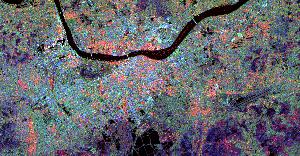
A Satellite view. North is towards right hand side.
Places
to Visit
Top
We are trying to list only some of the many places to visit. We hope
you will get a feel of the warmth and diversity of Kolkata!
(References : www.travel-westbengal.com
)
Victorial Memorial
 A
splendid architectural structure in white marble, modeled on the Taj
Mahal, was built in the early 20th century. In memory of Queen Victoria
and was formally inaugurated by the Prince of Wales in 1921 who later
became King Edward VIII of England. The stately bronze statue of the
queen near the entrance, the brass canons, wrought iron street lamps,
manicured lawns, gardens and pathways, the magical lighting effect in
the evening and a fairy tale 'Fountain of Joy' facing the memorial
building create an atmosphere of unforgettable charm. A
splendid architectural structure in white marble, modeled on the Taj
Mahal, was built in the early 20th century. In memory of Queen Victoria
and was formally inaugurated by the Prince of Wales in 1921 who later
became King Edward VIII of England. The stately bronze statue of the
queen near the entrance, the brass canons, wrought iron street lamps,
manicured lawns, gardens and pathways, the magical lighting effect in
the evening and a fairy tale 'Fountain of Joy' facing the memorial
building create an atmosphere of unforgettable charm.
Saheed Minar
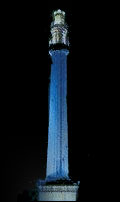 This 165
ft. High monument was erected by public subscription in 1828, to honour
Sir David Ochter Lony, a one- time resident of Malwa & Rajputana.
More recently, it has now been renamed 'Saheed Minar' to honour the
martyrs of the freedom struggle. An important landmark in Kolkata, it is
located at the Northern end of the Maidan. This 165
ft. High monument was erected by public subscription in 1828, to honour
Sir David Ochter Lony, a one- time resident of Malwa & Rajputana.
More recently, it has now been renamed 'Saheed Minar' to honour the
martyrs of the freedom struggle. An important landmark in Kolkata, it is
located at the Northern end of the Maidan.
Science City
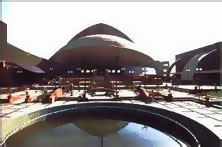 It is located on Kolkata's Eastern
Metropolitan Bypass. This 21st century marvel of science, communication
and environment is the first and only institution of its kind in
India.The pioneering effort of NCSM, in setting up open air Science
Parks has now added a new dimension to science teaching through a
process of discovery in the outdoor setting. Set amidst trees and lawns,
here one finds science out of doors and alive It is located on Kolkata's Eastern
Metropolitan Bypass. This 21st century marvel of science, communication
and environment is the first and only institution of its kind in
India.The pioneering effort of NCSM, in setting up open air Science
Parks has now added a new dimension to science teaching through a
process of discovery in the outdoor setting. Set amidst trees and lawns,
here one finds science out of doors and alive
Vidyasagar Setu
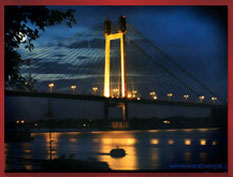 Vidyasagar
Setu a golden Gate Bridge look alike, 2kms downriver, was completed in
1994. It is a modern day engineering marvel and is the largest cable
stayed bridge in Asia. The bridge connects the twin cities of Kolkata
and Howrah. It was built at a cost of Rs. 388 crores. Unfortunately it
is not making the big difference that was envisaged, as the approaches
are too narrow to to handle the amount of traffic that use bridge, and
plans for widening the road are slow in implementation. Vidyasagar
Setu a golden Gate Bridge look alike, 2kms downriver, was completed in
1994. It is a modern day engineering marvel and is the largest cable
stayed bridge in Asia. The bridge connects the twin cities of Kolkata
and Howrah. It was built at a cost of Rs. 388 crores. Unfortunately it
is not making the big difference that was envisaged, as the approaches
are too narrow to to handle the amount of traffic that use bridge, and
plans for widening the road are slow in implementation.
Botanical Gardens
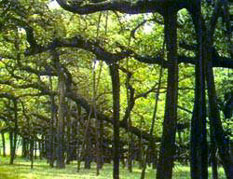 The extensive Botanical Gardens,
on the west bank of the Hoogly river, stretch forever 1 km along the
river and occupy 109 hectares. The gardens were originally founded in
1786 and administered by Colonel Kyd. It was from these gardens that the
tea now grown in Assam and Darjeeling was first developed. Trees of the
rarest kinds, from Nepal, Brazil, Penang, Java and Sumatra can be found
here. There are towering Mahogany trees, an avenue of Cuban Palms and an
Orchid House. Mango and Tamarind trees shade the grassy lawns. But the
main attraction of the garden is the 200 year old Banyan Tree,
claimed to have the second largest canopy in the world. It is the
world's largest, having a circumference of 330m. The extensive Botanical Gardens,
on the west bank of the Hoogly river, stretch forever 1 km along the
river and occupy 109 hectares. The gardens were originally founded in
1786 and administered by Colonel Kyd. It was from these gardens that the
tea now grown in Assam and Darjeeling was first developed. Trees of the
rarest kinds, from Nepal, Brazil, Penang, Java and Sumatra can be found
here. There are towering Mahogany trees, an avenue of Cuban Palms and an
Orchid House. Mango and Tamarind trees shade the grassy lawns. But the
main attraction of the garden is the 200 year old Banyan Tree,
claimed to have the second largest canopy in the world. It is the
world's largest, having a circumference of 330m.
The Palm House in the centre
of gardens is also well worth a visit. The gardens are over the Howrah
Bridge, 19Km by bus from Chowringhee. The gardens are open from sunrise
to sunset, and although they tend to be very crowded on Sunday, on other
days they are peaceful and make a pleasant escape from the hassles and
crowd of Kolkata.
Zoo & Horticultural Gardens
South of the Maidan, Kolkata's 16 hectare
zoo was opened in 1875. Some of the animals are displayed in near
natural environments, others in the pitiful conditions characteristics
of Third World zoos. It's open from sunrise to sunset.
Just south of the zoo on Alipore Rd
are the pleasant and quiet horticultural gardens. They are open from 8
am to 5 pm.
Kali Temple
 Rebuilt
in 1809 on the site of a much older temple. Kalighat ( as it is also
known ) is the actual temple from which Kalikata takes its name.
According to legend, when Siva's wife's corpse was cut up, one of her
fingers fell here. Since then it has been an important pilgrimage site. Rebuilt
in 1809 on the site of a much older temple. Kalighat ( as it is also
known ) is the actual temple from which Kalikata takes its name.
According to legend, when Siva's wife's corpse was cut up, one of her
fingers fell here. Since then it has been an important pilgrimage site.
Kali represents the destructive side
of Siva's consort and demands daily sacrifices. In the morning goats
have their throats slit here to satisfy the goddess' bloodlust. During
the day many poor people come here for a free feed. This is an extremely
busy temple.
Mother Teresa's Hospital for the Dying Destitute right
next door to the temple and you are welcome to visit. The temple is
about two km directly south of St Paul's Cathedral and is easily
accessible by metro.
BBD Bagh ( Dalhousie Square )
 When
Kolkata was the administrative centre for British India, BBD Bagh was
the centre of power. On the north side of the square stands the huge
Writers' Building, which dates from 1880. The East India Company's
writers have now been replaced by modern-day ones employed by the West
Bengal state government, and this is where all the quintuplicate forms,
carbon copies and red ink come from. Also on BBD Bagh is a rather more
useful place, the Kolkata GPO, and on the eastern side of the square is
the West Bengal tourist office. When
Kolkata was the administrative centre for British India, BBD Bagh was
the centre of power. On the north side of the square stands the huge
Writers' Building, which dates from 1880. The East India Company's
writers have now been replaced by modern-day ones employed by the West
Bengal state government, and this is where all the quintuplicate forms,
carbon copies and red ink come from. Also on BBD Bagh is a rather more
useful place, the Kolkata GPO, and on the eastern side of the square is
the West Bengal tourist office.
Jorasanko Tagore house
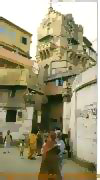 The rambling old Tagore
House is a centre for Indian dance, drama, music and other arts. This is
the birthplace of Rabindranath Tagore, India's greatest poet, and his
final resting place. It's just off Rabindra Sarani, north of BBD Bagh,
and is open Monday to Friday 10 am to 5 pm, Saturday upto 2 pm (closef
Sunday).There is a daily Bengali sound-and-light show at 6 and 7 pm. The rambling old Tagore
House is a centre for Indian dance, drama, music and other arts. This is
the birthplace of Rabindranath Tagore, India's greatest poet, and his
final resting place. It's just off Rabindra Sarani, north of BBD Bagh,
and is open Monday to Friday 10 am to 5 pm, Saturday upto 2 pm (closef
Sunday).There is a daily Bengali sound-and-light show at 6 and 7 pm.
Howrah Bridge
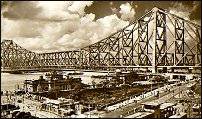 It is one of three bridges on the river Hooghly and is the
most famous symbol of not only Kolkata but also West Bengal. It is one of three bridges on the river Hooghly and is the
most famous symbol of not only Kolkata but also West Bengal.
Until 1943, the Hooghly River was crossed by a pontoon bridge which had
to be opened to let river traffic through. There was considerable
opposition to construction of a bridge due to fears that it would affect
the river currents and cause silting problems. This problem was
eventually avoided by building a bridge that crosses the river in a
single 450m span - there are no pylons at all within the river.
The cantilevered bridge, also known as Rabindra Setu, is similar in
size to the Sydney Harbour Bridge but carries a flow of traffic which
Sydney could never dream of .It is the busiest bridge in the world. It's
intriguing to stand at one end of the bridge at morning rush hour and
watch the procession of double-decker buses come across. They heel over
like yachts in a heavy wind due to the weight of passengers hanging onto
the sides. In between are lumbering bullock carts, hordes of
bicycles and even the odd car. The ferries running from below Howrah
Station are a more convenient way to cross the river and give you a good
view of the bridge.
Indian
Museum
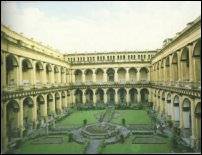 This museum was established in 1878 on Jawaharlal Nehru Road.
The museum is built in Italian architectural style and is considered as
the largest museum in the country and one of the best in Asia. The
largest museum in the country, the museum has six sections: Art,
Archaeology, Anthropology, Geology, Zoology and Industry (economic
botany). From the Egyptian mummy to the skeleton of the whale and some
rare statues; the museum has every thing. One of the rooms has a
collection of meteorites. The museum also has a unique fossil collection
of prehistoric animals which includes a giant crocodile and a huge
tortoise. The art collection has many fine pieces from Orissa and other
temples and superb example of Buddhist Gandharan art. This museum was established in 1878 on Jawaharlal Nehru Road.
The museum is built in Italian architectural style and is considered as
the largest museum in the country and one of the best in Asia. The
largest museum in the country, the museum has six sections: Art,
Archaeology, Anthropology, Geology, Zoology and Industry (economic
botany). From the Egyptian mummy to the skeleton of the whale and some
rare statues; the museum has every thing. One of the rooms has a
collection of meteorites. The museum also has a unique fossil collection
of prehistoric animals which includes a giant crocodile and a huge
tortoise. The art collection has many fine pieces from Orissa and other
temples and superb example of Buddhist Gandharan art.
Eden
Gardens
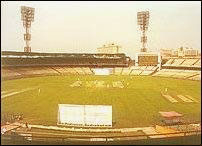 In the North-West corner of the Maidan
are small & pleasantly laid out Eden Gardens. The gardens were
created in 1840 and named after the sister of Lord Auckland, the former
governor general. The idea was to make a Biblical - style garden of Eden
in India. The expanse dotted with beautiful trees and shrubs is
intersected by winding paths, and there is a large artificial lake.
Alongside the gardens, is the world famous Eden Gardens cricket stadium.
The stadium is supposed to be the largest in Asia with a seating
capacity of more than a lakh spectators. The Kolkata cricket ground,
where International test & one day matches are held, is also with in
the gardens. Near the gardens you can take a pleasant walk along the
bank of hoogly river. In the North-West corner of the Maidan
are small & pleasantly laid out Eden Gardens. The gardens were
created in 1840 and named after the sister of Lord Auckland, the former
governor general. The idea was to make a Biblical - style garden of Eden
in India. The expanse dotted with beautiful trees and shrubs is
intersected by winding paths, and there is a large artificial lake.
Alongside the gardens, is the world famous Eden Gardens cricket stadium.
The stadium is supposed to be the largest in Asia with a seating
capacity of more than a lakh spectators. The Kolkata cricket ground,
where International test & one day matches are held, is also with in
the gardens. Near the gardens you can take a pleasant walk along the
bank of hoogly river.
Top
Festivals
of Kolkata
( References: www.calonline.com
)
"Baro mashe, tero parbon" -12 months, 13 festivals.
The Bengali Saying in fact, underestimates the number of festivals,
civil and religious, celebrated in Calcutta, where communities belonging to all religions and from all over
the subcontinent have brought along their own local cults which even
within the Hindu religion vary from area to area.
If there is an activity which can be said to be
typical of Calcutta, it is Puja. Basically puja is an
offering to the presiding deity, performed by an
individual, a family, a community, a group of people
or a locality. The offering may be of flowers, incense, fire, or, in
some cases, animal sacrifices.
The community puja is one of the most spectacular
events in Calcutta. It starts with the ordering of the
murthi, a clay image of the deity at Kumartuli in
North Calcutta or Patuapara at Kalighat. The murthi is
fashioned from a straw armature coated with clay and
modelled to the image of the deity, then mounted on a structure
embellished with sola pith or tinsel, and installed in the Puja Pandal,
a dias made of bamboo and pleated cloth, decorated with Chandeliers and
neon lights. Musical and cultural shows, exhibitions and fairs are held
around the pandal.
A festival lasts several days, 10 in case of Durga
Puja. On the occasion of Durga and Kali Pujas, special drummers, the
Dhakis, using huge powerful drums made of a hollow mango tree branch and
goat skin, arrive from all over Bengal to play during the festival.
Besides Hindi and pop music lasting all night from loudspeakers, the
rumble of their drums can be constantly heard all over the city on these
occasions. On the last day, the murthi is carried by cheering devotees
in festive processions, someetimes preceded by bagpipes or bandparties,
to the river Hooghly where it is immersed. The main Hindu festivals in
Calcutta are Durga Puja, Lakshmi Puja, Kali Puja and Saraswati Puja.
Durga Puja :
 The start of winter coincides with Durga Puja
in October, the most impotant festival in Bengal.
According to Hindu mythology, all gods and goddesses
of thee Hindu pantheon endowed Durga with a portion of
their own energy to give her strength, or shakti, to
destroy the evil forces. Some 2,000 pandals are
erected throughout the city. The image of Durga shows her slaying the
most powerful demon, Mahisasur. The start of winter coincides with Durga Puja
in October, the most impotant festival in Bengal.
According to Hindu mythology, all gods and goddesses
of thee Hindu pantheon endowed Durga with a portion of
their own energy to give her strength, or shakti, to
destroy the evil forces. Some 2,000 pandals are
erected throughout the city. The image of Durga shows her slaying the
most powerful demon, Mahisasur.
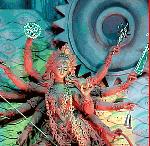 This is the season of gifts. New clothes are purchased. Shops oveflow
with the latest goods. People take to the streets to visit the thousands
of puja pandals which spring virtually at every street corner. A majical
atmosphere prevails and the city remains bright with lightings and pandle hoppers through all night. The puja climaxes on
Mahadashami, the 10th day when the image is carried in decorated carts
or trucks in festive processions to be immersed in river Hooghly.
This is the season of gifts. New clothes are purchased. Shops oveflow
with the latest goods. People take to the streets to visit the thousands
of puja pandals which spring virtually at every street corner. A majical
atmosphere prevails and the city remains bright with lightings and pandle hoppers through all night. The puja climaxes on
Mahadashami, the 10th day when the image is carried in decorated carts
or trucks in festive processions to be immersed in river Hooghly.

Northern Indian communities celebrated the
festival of Dussehra on that day commemorating Rama's victory over the
devil Ravana, symbolising the triumph of good over evil. At sunset,
huge effigies of Ravana, his son and his brother are burned on the
maidan.
Saraswati Puja
:
Late in January or early February,
Saraswati Puja, the festival of Goddess of Learning,
is celebrated by students, artists and professors.
Dol Purnima :
In March, the festivals of Dol Purnima, or
Holi, as it is called by Northern Hindus, heralds the
short spring season. People from all walks of life
celebrate the coming of spring by smearing each other with powdered colours - "abir", red
especially, spraying coloured water at passers-by
and drinking bhang, a mildmilk beverage laced with marijuana, by. Social
barriers are broken. It is a time when poor and rich,
lower-cast touch upper-cast enjoy with each other.
Nabobarsho :
Noboborsho, on mid of April, marks the
begining of Bengali New Year and also the begining of
summer. Businessman carry their new halkhata account
books, statuees of Ganesh and Lakshmi to the Kali
Temple for blessings. In the evening, customers make
token payment to their favourite shops while owwners offer them sweets.
Shops are decorated with garlands, auspicious mango leaves, sola pith
ornaments and young banana.
On Charak Puja, the eve of the Bengali New
Year, devotees at Chatu Babu Bazar attach themselves to giant rotating
swings symbolising the cycles of life.
A few days after
noboborsho, on Mahabir Jayanti, the birth anniversary of last and
geatest Jain prophets, there are processions of the Svetamber Sect from
Harrison Road to Kalakar Street, and of the Digambar Sect from
Belgachaia to Baisakh Lane.
Laxmi Puja :
In the month of October, five days after
Mahadashami, on full moon, is the festivals of the
Goddess of properity Laxmi who is worshipped daily in
most Hindu household for the family's wellbeeing.
Public Pujas are performed in the same permises as for
Durga Puja.
Kali Puja :
 Two weeks later,
is another popular feestival, Kai Puja. Kali is the
Goddess of destruction. The image of Kali usually shows her foot on Lord
Shiva's chest, a severed head in one hand, her sword in the other, and
wearing a garland of skulls. Kali is worshipped as the Mother Goddess
who protects from evil. She also epitomises strength or shakti and the
darker side of life. The actual puja takes place at midnight on the day
of the new moon. Two weeks later,
is another popular feestival, Kai Puja. Kali is the
Goddess of destruction. The image of Kali usually shows her foot on Lord
Shiva's chest, a severed head in one hand, her sword in the other, and
wearing a garland of skulls. Kali is worshipped as the Mother Goddess
who protects from evil. She also epitomises strength or shakti and the
darker side of life. The actual puja takes place at midnight on the day
of the new moon.
Kali Puja coincides with Diwali, the North Indian New Year, the
festivals of lights. House-holds clean their houses and light up candles
all over their houses. Children and adults set off firecrackers all
night. No one sleeps on that night.
Two days after that is Brother's Day, Bhai Phonta or Bhatri Dvitiya.
Elder sisters dip their little fingers into kajol, a mixture of ghee,
rice-paste and almond paste, and put a mark on their brothers' forehead.
Christmas :
Christmas is widely celebrated in Calcutta,
not only by the Christian community. Streets are illuminated. There are
parties in clubs and hotels. The best masses are at St. Paul's
Cathedral, candle lit on this occasion, at St. Andrew's Kirk and at the
Murgihatta Catholic Cathedral. A pandal with a Nativity erected on
Dharamtala Street (Lenin Sarani) in front of the St. Thomas Church.
The Muslim Festivals :
Muslim festivals are celebrated with
intensity in Calcutta. During Bakriid, celebration of
the hajis, the pilgrims to the Holy Mecca and
Idulfitr, marking the end of Ramazan, the northern
part of the Maidan becomes the prayer grounds for Muslims who gather
around the Saheed Minar while the muezzin leads the sessions from the
top the monument.
The Shiite processions on Ashoura along Chitpore Road and, in
Metiaburuz, Kidderpore, Razabazar, Narkeldanga, Beliaghata and
Manicktola, are an impressive spectacle. They are led by a white horse,
Hussain's mount, followed by tazias, preciously handicrafted replicas of
Hussain's grave, and flagellants who alternatively pound their chests
singing "hay Hassan, hay Hussain" and flagellate themselves with razor
blades attached to thee end of a multi-tailed whip.
Top
Climate
of Kolkata
Kolkata is located on the great gangetic
delta. Its climate is very much influenced by the sea. Kolkata has a
very tropical savanna type of climate. Kolkata is dominated by 3 seasons
– summer, monsoon,winter. The summer is hot and humid and
continues from April to June. Summer is dominated by strong
south-westerly monsoon winds. Monsoon arrives in mid June and stays upto
September. Winter is the most pleasant time in Kolkata. Winter lasts for
3 months-December,January,February. Early morning mists are common in
winter.
The annual mean temperature is 26.8'C.The maximum temperature often
exceed 40’C.The temperature does not fall below 10’C.
Maximum rainfall occurs during the monsoon in August (306 mm) and the
average annual total is 1,582 mm (WMO, 1971).
Total duration of sunshine is 2,528 hours per annum with maximum
rainfall occurring in March.
Top
Transport
Virtually all the different modes of
transport that clog the streets of Calcutta - trams, buses, rickshaws,
metered taxis, and minibuses - add to the problem of congestion.
However, the Metro , India's first and Calcutta's pride and joy,
provides a fast, clean and efficient way to get around. It's also very
easy to use, as it consists of just the one line running on a
north-south axis.
The river is also used for transport, with the ghats near Eden Gardens
at the hub of a ferry system. The most pleasant way to beat the traffic
is to take one of the very regular ferries from Chandpal Ghat to Howrah
Station; other sailings head downriver from Armenian, Chandpal or Babu
ghats to the Botanical Gardens, although the running of this route is
erratic. Of more use to commuters than tourists, a circular railway
loops south from Sealdah before moving upriver along the Strand and
Princep Ghat, past Howrah Bridge and eventually to Dum Dum. While using
public transport, be wary of pickpockets , especially on crowded buses.
The Metro
Despite a couple of small fires in recent
years, Calcutta's Russian-designed Metro , inaugurated in 1984, is every
bit as good as its inhabitants proudly claim, a spotless contrast to the
streets above, with trains operating punctually
Buses and minibuses
Calcutta supports a vast and complicated
bus network, in operation each day between roughly 5am and 11pm, and
subject to overcrowding and attendant pickpocketing problems. The
profusion of bus routes, many privately run, is best explained
Taxis
Taxis in Calcutta prove to be extremely
good value, especially on long journeys such as to and from the airport
(around Rs130 for a twenty-kilometre ride), but a few drivers can be
unwilling to go anywhere for less than Rs50,
Trams
Calcutta's cumbersome trams , barely
changed since they started operating in 1873, are on their way out;
their inability to deviate from fixed rails to cope with the city's
crazy traffic makes them more of a nuisance
Rickshaws, auto-rickshaws and cycle
rickshaws
Calcutta is the only city in India to have
human-drawn rickshaws , which are only available in the central areas of
the city, especially around New Market. There are cycle ricksaws and
auto-rickshaws available in the city. Though slow, cycle-rickshaws
provide a polution free journey.
Top
Industries
The industrial
environment in West Bengal is highly conducive for fresh investment. The
infrastructural facilities in the State are good. The ideal locations
for setting up of an Industrial unit a number of Growth Centres have
been developed by the State, wherein all industrial infrastructure like
power, water, sheds, land, etc. are available. The Growth Centres are
planned in such a manner that availability of skilled as well as
unskilled labour is assured from the neighbouring towns. Also, these
Growth Centres have easy access to the socio-economic infrastructure
offered by these towns.
As the number of Growth Centres have already been established and some
more such centres are comming up. Three Mega Growth Centres -one each in
the Districts of Birbhum, Jalpaiguri and Malda - will be set up in
addition to these Growth Centres. An Export Processing Zone (EPZ) is
already operational at Falta in the district of 24-Parganas (South).
Situated on the left bank of the river Hoogly in a pollution free
environment, the EPZ at Falta provides excellent infrastructure for
Export Oriented Units(EOUs). With a view to identifying infrastructural
and other related requirements to faclititate further industrial
development, the State Government has constituted a high powered
Committee on infrastructural development under the Chairmanship of
Minister of State in charge of Commerce & Industries Department.
The Government of West Bengal attaches special emphasis on the growth
and development of electronic industies. An electronic complex has been
set up in a very convenient location, close to the city of Calcutta and
also the Calcutta Airport. The complex provides developed land and
facilities like power, water, road network and communication facilities.
The Electronics complex also includes a Standard Design Factory (SDF)
building.
The State Government also offers attactive incentives to encourage
growth of industrial activities in West Bengal. The Government has
inctroduced a New Incentive Scheme with effect from 1.4.1993. This
Scheme provides special encouragement towards setting up of industries
in the backward areas. Apart from incentives like state Capital
Investment Subsidy, Waiver of Electricity Duty, Sales Tax
Deferment/Remission etc. the new incentive scheme has providisions for
treating deffered Sales Tax as deemed loan, allotment of land in Growth
Centres on soft terms of payments, subsidy for conversion to piped coal
gas as input and spcial incentives for multiplier industries with fixed
capital investment exceeding Rs100 crores and minimum employment of 100
persons.
There is a spcial NRI cell to provide information and guidance and also
assitance to NRIs and foreign investors wishing to invest in the State.
The Cell functions under a high powered NRI investment Guidance and
Monitoring Committee(NRIGMC) under the Chairmanship of the Secretary,
Commerce & Industries Department.
Top
Eminent Personalities of Kolkata
Rabindranath Tagore :
Rabindranath Tgore, the great poet, patriot and social reformer was the
first Asian to receive Nobel Prize for literature in 1913 .
Tagore was knighted by the ruling British Government in 1915, but
within a few years he resigned the honour as a protest against British
policies in India.
Netaji Subhas Chandra Bose :
He was a fierce and popular freedom fighter in pre-independent
India. He was the president of the Indian National Congress in
1937 and 1939.Netaji founded a nationalist force called the
Indian National Army. He started a mass movement using Indian resources
and men for the great war. To him, it had no sense to further bleed the
poor Indians for the sake of colonial and imperial nations. There was a
tremendous response to his call and the British immediately
imprisoned him. He went for a hunger strike. His health
detoriorated and on the 11th day of fasting he was freed and
placed under house arrest. But he disappeared from his house in early
1941.In November 1941 ,his broadcast from german radio sent shock waves
to the british and electrified the Indians who realized their leader
was working in a master plan to free their motherland. Bose allied with
Germany and Japan to fight against The British. In the beginning of
1943, a most hazardous journey was undertaken by him. He traversed
under water, covering thousands of miles, crossing enemy territories.
He was in the Atlantic, the Middle East, Madagascar and the
Indian ocean. Battles were being fought over land, in the air and there
Battles were being fought over land, in the air and there were mines in
the sea. At one stage he traveled 400 miles in a rubber dingy to reach
a Japanese submarine, which took him to Tokyo. He was warmly received
in Japan and was declared the head of the Indian army, which consisted
of about 40,000 soldiers from Singapore and other eastern regions. Bose
called it the Indian National Army (INA) and a government by the name
"Azad Hind Government" was declared on the 21st of October 1943.INA
freed the Andaman and Nicobar islands from the British and were renamed
as Swaraj and Shaheed islands. The Government started functioning.Bose
wanted to free India from the Eastern front. He had taken care that
Japanese interference was not present from any angle. Army leadership,
administration and communications were managed by Indians only. Subhash
Brigade, Azad Brigade and Gandhi Brigade were formed.
INA marched through Burma and occupied
Coxtown on the Indian Border. A touching scene ensued when the solders
entered their 'free' motherland. Some lay down and kissed, some placed
pieces of mother earth on their heads, others wept. They were now
inside of India and were determined to drive out the British! Delhi
Chalo (Let's march to Delhi) was the war cry. The bombing of Hiroshima
and Nagasaki changed the history of mankind. Japan had to surrender.
Bose was in Singapore at that time and decided to go to Tokyo for his
next course of action. Unfortunately, there was no trace of him from
that point. He was just 48 and his death or disappearance is
still a mystery. The Indian people were so much enamored of Bose's
leadership qualities, fearlessness and mysterious adventures, that he
had become a legend.
Sri Aurobindo : Sri Aurobindo, the great patriot participated
immensely in freedom struggle. He became a leader of the Nationalist
Party and his editorials in the Bande Mataram at once made him an
all-India figure. In 1810, Sri Aurobindo withdrew from the political
field and sailed for Pondicherry, to devote himself entirely to his
evolving spiritual mission.
Khudiram Bose :
Khudiram Bose, a true martyr of India was involved with a secret
extremist group called Yugantar along with Aurobindo Ghosh, Barin
Ghosh, Raja Subodh Mallik. Yugantar planned Kingsford's (the notorious
Chief Presidency Magistrate ) death and Khudiram Prafulla Chaki
were chosen for the job. He was hanged to death on 11th aug, 1908.
Satyendra Nath Bose : S.N.Bose, an Indian mathematician and theoretical
physicist, is known for his contributions in the fields of statistical
mechanics and quantum mechanics particularly in regard to photons. He
wrote a paper on the statistics of photons now named as 'Bose
Statistics'. Fundamental particles that obeyed his statistical rules
were later named 'bosons' One of his important publication is “Planck's
Law and the Hypothesis of Light Quanta".
Jagadish Chandra Bose : Jagdish Chandra Bose had put India on the
scientific world map with his ingenuity and scientific flair. He
conducted bold experiments in Physics, Botany and Physiology. JC Bose
demonstrated the existence and propaganda of wireless waves in 1885.
His work on devices for receiving the polarization of electric waves
was later exploited by Marconi who designed a long distance radio
signalling device. He was able to show the similarity in response of
the living and non-living to various types of stress and strains.
Having discovered this similarity to electric response in animal tissue
and inorganic substances Bose now started exploring the response in
plants to external stimuli. He was able to establish this similarity in
plants too .One of Bose's amazing achievements was his invention of the
'crescograph'. The crescograph was an electrical instrument that could
measure the growth of a plant accurately.
Raja Ram Mohan Roy :
Raja Ram Mohan Roy, the maker of modern India fought to abolish
SATI(the horrible c ustom of burning the living wife with the dead
husband) and put an end to it. William Bentinck administration passed a
law in 1829 banning the practice of Sati .Roy first realised that an
understanding of "modern" subjects like
physics,chemistry,biology,mathematics,English would give Indians a
better standing in the world.He also founded the Bramho Samaj.
Pundit Ishwar Chandra Vidyasagar :
He was a great Sanskrit pundit, educator, reformer, writer,
philanthropist. He fought against polygamy and child marriage. He took
initiative to legalize widow re-marriage and encouraged it a lot. He
also helped the distressed people. Vidyasagar was the founder of
several schools, many of which were for girls.
Swami Vivekananda : Swami Vivekananda was the leading disciple of Sri
Ramakrishna. His lectures and books provide the best explanation of the
Upanishads in modern literature. The Upanishads are the original source
of Vedanta.Swami Vivekananda visited the West at the end of the 19th
century, and his influence is felt to this day. His message of
uncompromising strength, devotion to the truth, unity of all creeds,
and dedication to the higher pursuits of life, re-invigorated the
spiritual landscape of America and Europe. His work in India provided a
genuine alternative to the sweeping materialism that resulted from the
scientific achievements of his century.
Nobel laureates
All Nobel laureates of India have been associated with Calcutta at some
point of time. The city has produced five Nobel Prize laureates so
far . They are (as chronologically awarded):
Sir Ronald Ross (1902 Medicine),
Rabindranath Tagore (1913 Literature),
Sir C.V. Raman (1930 Physics),
Mother Teresa (1977 Peace) and lastly
Amartya Sen (1998 Economics)
Scientists
Scientific greats of Calcutta include, in approximately chronogical
order, the multifaceted geniuses W.B. O'Slaughnessy, Sir Jagadish
Chandra Bose, Sir Prafulla Chandra Ray, the physicists Meghnad Saha,
Satyendra Nath Bose, statistician Prasanta Chandra Mahalanobis, and
genetic scientist Ananda Mohan Chakraborty. The first in-vitro
fertilization (to produce test tube baby "Durga") in India (and second
in the world) was performed by city doctor Dr. Subhash Mukhopadhyay on
October 3, 1978.
Top
A
Consise History
In 1690 Job Charnok, an agent of East
India Company setteled in Kolkata. In 1698 East India Co bought three
villages Gobindapur, Sutanuti, Kolkata from local landlord Sabarna
Chowdhury. In 1699 East India Company started developing Calcutta as a
Presidency city. In1715 British people completed building the Old Fort.
In 1717 The Mughal emperor Farrukh-siyar granted the East India Company
freedom of trade in return for a yearly payment of 3,000 rupees. In 1727
As per the order of King George I , a civil court was set up. The
city corporation was established and Hallwell became the first mayor of
the city. In 1756 Siraj-ud-daulla attacks Calcutta and conquered. He
changed the name of the city to Alinagar. Again in 1757 23rd June,
British people ( under the leadership of Clive) defeated
Siraj-id-daulla at Plassey (in Nadia district).
In 1757 British first printed currency bill in Calcutta mint.
In year 1772 Calcutta became the capital of British India when the
first governor-general, Warren Hastings, transferred all important
offices to the city from Murshidabad .
In 1780 James Hicky established a printed press and published first
news paper, "The Bengal Gazzette".
The first official news paper , "The Calcutta Gazzette", was published
in 1784.In 1784 Sir William Jones took initiative and established The
Asiatic Society.
The Governor House ( presently Raj Bhawan ) was built in 1804.
In 1818 First Bengali Magazine, "Digdarshan", was published from
Sreerampur, with the help of David Hare.
In 1817 The Hindu College ( presently Presidency College ) was
established with efforts from Rammohan Roy, David Hare and Radhakanta
Dev. Initially the college started with 20 students. Rammohan Roy was
successful in making 'satidaho' (a Hindu rule) banned by British General
Bentinck in year 1829.
In 1854 First Railways in India was established ( from Calcutta to
Hooghly ).
In 1857 The University of Calcutta was established.
First Tram car ( horse drawn )was drawn in Calcutta in 1873.
In 1875 "The Statesman", leading English Daily newspaper, started.
The Indian Museum was built in 1875.
In 1883 Surendra Nath Banerjee called for a National convention ( which
led to the forming of Indian National Congress in 1885 at Bombay ).
In 1886 Second convention of Indian National Congress at
Calcutta. Indian Football Association established in 1888.
In 1896 First motor car appeared on city's street.
In 1902 First Electric tram car was driven from Esplanade to
Kidderepore.
In 1905 Lord Curzon, viceroy of India, tried to partition Bengal. There
was a strong protest. And finally he failed to do so.
In 1911 British moved the capital of India from Calcutta to Delhi
In 1911 A local football team, Mohanbagan, defeated British in IFA
shield final and created national sensation.
Rabindranath Tagore, the great philosopher, poet and writer received
Nobel Prize in literature in 1913.
In 1921 King Edward VIII inaugurated the Victoria Memorial building.
In 1924 Chittaranjan Das, was elected as the first Indian mayor
of the city of Calcutta.
Agnes Goinxha Bejaxhiu (Mother Teresa), came to Calcutta to join Bengal
Loreto missionin in 1929.
In 1939 The World War II hit Calcutta.
Tagore died in 1941 .
In 1941 Subhash Chandra Bose escaped from house arrest by British.
In 1947 India gained independence. Bengal was divided , Calcutta became
the capital city of the state of West Bengal in India. Dr. Prafulla
Chandra Ghosh became the first Chief Minister of West Bengal, followed
by Dr. Bidhan Chandra Roy. Calcutta and surrounding places were flooded
with people from East Pakistan ( now Bangladesh ) as a result of the
partition.
The Naxalite Movement hit the city resulting arrests of hundreds of
youths and creating enormous tension among city dwellers in 1970-71.
In 1975 First TV transmission started in the city from August 9th.
Mother Teresa, a permanent resident of Calcutta was awarded Nobel Peace
Prize in 1979.
In 1984 Metro, the first underground railway in India, started from
Tollygunge to Esplanade and First color TV transmission
started from TV centre ( DoorDarshan ).
In 1989 France's highest civilian award, Legion d'Honour was conferred
upon Satyajit Ray by President F. Mitterrand in Calcutta.
In 1992 Satyajit Roy, film director, received prestigious "Life Time
Achievement" Oscar award and "Bharat Ratna". He died in the same year.
First cellular phone service starts in the city in 1995.
In 1997 Mother Teresa died in Calcutta.
2001 Calcutta was officially renamed as 'Kolkata' from 1st Januray,
Founder and date of foundation
The city High Court recently gave a ruling
that Job Charnock is not the founder of the city and Calcutta has no
birthday. According to the Court, the city owes its genesis in the
Maurya and Gupta period and it was an established trading post
long before the Slave Dynasty of the Delhi Sultanate, the Mughals, the
Portuguese, the French or the British established a modern township
there. References to the existence of an ancient riverine port exist in
the travel journals of Chinese scholars and Persian merchants dating
from the time preceding the birth of Christ. The Hindu epic Mahabharata,
lists the King of “Vanga”, as having fought alongside the Kauravas in
the great Mahabharata
Top
Airline Offices
Here are some of the Aitline Offices in
Kolkata. All the informations may not be upto date.
(References: www.calcuttaairport.com)
AIR
FRANCE
41, J.L. Nehru Road. Kolkata-700 071.
Phone- 2226-6161
AIR INDIA
50, J.L. Nehru Road. Kolkata-700 071.
Phone- 2282-2356/57/1187 Fax - 91-33-2282-7875
BRITISH AIRWAYS
41, J.L Nehru Road. Kolkata-700 071.
Phone- 2288-3451/53/54, 2246-9161 Fax - 91-33-2288-4605
CATHAY PACIFIC
1, Middleton Street. Kolkata-700 016.
Phone- 2287-0275, 2240-3211 Telfax - 240-3211
GULF AIR
230, A.J.C. Bose Road. Kolkata-700 020.
Phone- 2247-7783/5576
INDIAN AIRLINES
39, Chittaranjan Avenue. Kolkata-700 012.
Phone- 2236-0810/0730/4433/2548
JET AIRWAYS
18D, Park Street. Kolkata-700 016.
Phone- 2229-2227/0740/2048 Fax - 91-33-2245-6866
LUFTHANSA
Dum Dum Airport. Kolkata
Phone- 2511-8528
LUFTHANSA AIRLINES
30A/B, J.L. Nehru Road. Kolkata-700 071.
Phone- 2229-9369/66
SAHARA INDIA AIRLINES
2A, Shakespeare Sarani. Kolkata-700 071.
Phone- 2282-7686/8969 Fax - 91-33-2282-4910
SAUDI ARABIAN AIRLINES
Park Street. Kolkata
Phone- 2229-4828/1156
SINGAPORE AIRLINES
235/1, A.J.C. Bose Road, Hotel HHI. Kolkata-700 020.
Phone- 2280-9898/8882
SWISS AIR
46C, J.L. Nehru Road, Everest House. Kolkata-700 071.
Phone- 2288-4643/44
Top
References
www.calcuttaweb.com
www.netguruindia.com
www.bengalonthenet.com
www.kolkatavision.com
www.travelwestbengal.com
www.calcuttaairport.com
www.banglalive.com
This page has been contributed by Tamalika Gupta, Dept of IT, 2005
batch.
|


 A
splendid architectural structure in white marble, modeled on the Taj
Mahal, was built in the early 20th century. In memory of Queen Victoria
and was formally inaugurated by the Prince of Wales in 1921 who later
became King Edward VIII of England. The stately bronze statue of the
queen near the entrance, the brass canons, wrought iron street lamps,
manicured lawns, gardens and pathways, the magical lighting effect in
the evening and a fairy tale 'Fountain of Joy' facing the memorial
building create an atmosphere of unforgettable charm.
A
splendid architectural structure in white marble, modeled on the Taj
Mahal, was built in the early 20th century. In memory of Queen Victoria
and was formally inaugurated by the Prince of Wales in 1921 who later
became King Edward VIII of England. The stately bronze statue of the
queen near the entrance, the brass canons, wrought iron street lamps,
manicured lawns, gardens and pathways, the magical lighting effect in
the evening and a fairy tale 'Fountain of Joy' facing the memorial
building create an atmosphere of unforgettable charm. This 165
ft. High monument was erected by public subscription in 1828, to honour
Sir David Ochter Lony, a one- time resident of Malwa & Rajputana.
More recently, it has now been renamed 'Saheed Minar' to honour the
martyrs of the freedom struggle. An important landmark in Kolkata, it is
located at the Northern end of the Maidan.
This 165
ft. High monument was erected by public subscription in 1828, to honour
Sir David Ochter Lony, a one- time resident of Malwa & Rajputana.
More recently, it has now been renamed 'Saheed Minar' to honour the
martyrs of the freedom struggle. An important landmark in Kolkata, it is
located at the Northern end of the Maidan. It is located on Kolkata's Eastern
Metropolitan Bypass. This 21st century marvel of science, communication
and environment is the first and only institution of its kind in
India.The pioneering effort of NCSM, in setting up open air Science
Parks has now added a new dimension to science teaching through a
process of discovery in the outdoor setting. Set amidst trees and lawns,
here one finds science out of doors and alive
It is located on Kolkata's Eastern
Metropolitan Bypass. This 21st century marvel of science, communication
and environment is the first and only institution of its kind in
India.The pioneering effort of NCSM, in setting up open air Science
Parks has now added a new dimension to science teaching through a
process of discovery in the outdoor setting. Set amidst trees and lawns,
here one finds science out of doors and alive Vidyasagar
Setu a golden Gate Bridge look alike, 2kms downriver, was completed in
1994. It is a modern day engineering marvel and is the largest cable
stayed bridge in Asia. The bridge connects the twin cities of Kolkata
and Howrah. It was built at a cost of Rs. 388 crores. Unfortunately it
is not making the big difference that was envisaged, as the approaches
are too narrow to to handle the amount of traffic that use bridge, and
plans for widening the road are slow in implementation.
Vidyasagar
Setu a golden Gate Bridge look alike, 2kms downriver, was completed in
1994. It is a modern day engineering marvel and is the largest cable
stayed bridge in Asia. The bridge connects the twin cities of Kolkata
and Howrah. It was built at a cost of Rs. 388 crores. Unfortunately it
is not making the big difference that was envisaged, as the approaches
are too narrow to to handle the amount of traffic that use bridge, and
plans for widening the road are slow in implementation.  The extensive Botanical Gardens,
on the west bank of the Hoogly river, stretch forever 1 km along the
river and occupy 109 hectares. The gardens were originally founded in
1786 and administered by Colonel Kyd. It was from these gardens that the
tea now grown in Assam and Darjeeling was first developed. Trees of the
rarest kinds, from Nepal, Brazil, Penang, Java and Sumatra can be found
here. There are towering Mahogany trees, an avenue of Cuban Palms and an
Orchid House. Mango and Tamarind trees shade the grassy lawns. But the
main attraction of the garden is the 200 year old Banyan Tree,
claimed to have the second largest canopy in the world. It is the
world's largest, having a circumference of 330m.
The extensive Botanical Gardens,
on the west bank of the Hoogly river, stretch forever 1 km along the
river and occupy 109 hectares. The gardens were originally founded in
1786 and administered by Colonel Kyd. It was from these gardens that the
tea now grown in Assam and Darjeeling was first developed. Trees of the
rarest kinds, from Nepal, Brazil, Penang, Java and Sumatra can be found
here. There are towering Mahogany trees, an avenue of Cuban Palms and an
Orchid House. Mango and Tamarind trees shade the grassy lawns. But the
main attraction of the garden is the 200 year old Banyan Tree,
claimed to have the second largest canopy in the world. It is the
world's largest, having a circumference of 330m.
 Rebuilt
in 1809 on the site of a much older temple. Kalighat ( as it is also
known ) is the actual temple from which Kalikata takes its name.
According to legend, when Siva's wife's corpse was cut up, one of her
fingers fell here. Since then it has been an important pilgrimage site.
Rebuilt
in 1809 on the site of a much older temple. Kalighat ( as it is also
known ) is the actual temple from which Kalikata takes its name.
According to legend, when Siva's wife's corpse was cut up, one of her
fingers fell here. Since then it has been an important pilgrimage site. When
Kolkata was the administrative centre for British India, BBD Bagh was
the centre of power. On the north side of the square stands the huge
Writers' Building, which dates from 1880. The East India Company's
writers have now been replaced by modern-day ones employed by the West
Bengal state government, and this is where all the quintuplicate forms,
carbon copies and red ink come from. Also on BBD Bagh is a rather more
useful place, the Kolkata GPO, and on the eastern side of the square is
the West Bengal tourist office.
When
Kolkata was the administrative centre for British India, BBD Bagh was
the centre of power. On the north side of the square stands the huge
Writers' Building, which dates from 1880. The East India Company's
writers have now been replaced by modern-day ones employed by the West
Bengal state government, and this is where all the quintuplicate forms,
carbon copies and red ink come from. Also on BBD Bagh is a rather more
useful place, the Kolkata GPO, and on the eastern side of the square is
the West Bengal tourist office. The rambling old Tagore
House is a centre for Indian dance, drama, music and other arts. This is
the birthplace of Rabindranath Tagore, India's greatest poet, and his
final resting place. It's just off Rabindra Sarani, north of BBD Bagh,
and is open Monday to Friday 10 am to 5 pm, Saturday upto 2 pm (closef
Sunday).There is a daily Bengali sound-and-light show at 6 and 7 pm.
The rambling old Tagore
House is a centre for Indian dance, drama, music and other arts. This is
the birthplace of Rabindranath Tagore, India's greatest poet, and his
final resting place. It's just off Rabindra Sarani, north of BBD Bagh,
and is open Monday to Friday 10 am to 5 pm, Saturday upto 2 pm (closef
Sunday).There is a daily Bengali sound-and-light show at 6 and 7 pm. It is one of three bridges on the river Hooghly and is the
most famous symbol of not only Kolkata but also West Bengal.
It is one of three bridges on the river Hooghly and is the
most famous symbol of not only Kolkata but also West Bengal. This museum was established in 1878 on Jawaharlal Nehru Road.
The museum is built in Italian architectural style and is considered as
the largest museum in the country and one of the best in Asia. The
largest museum in the country, the museum has six sections: Art,
Archaeology, Anthropology, Geology, Zoology and Industry (economic
botany). From the Egyptian mummy to the skeleton of the whale and some
rare statues; the museum has every thing. One of the rooms has a
collection of meteorites. The museum also has a unique fossil collection
of prehistoric animals which includes a giant crocodile and a huge
tortoise. The art collection has many fine pieces from Orissa and other
temples and superb example of Buddhist Gandharan art.
This museum was established in 1878 on Jawaharlal Nehru Road.
The museum is built in Italian architectural style and is considered as
the largest museum in the country and one of the best in Asia. The
largest museum in the country, the museum has six sections: Art,
Archaeology, Anthropology, Geology, Zoology and Industry (economic
botany). From the Egyptian mummy to the skeleton of the whale and some
rare statues; the museum has every thing. One of the rooms has a
collection of meteorites. The museum also has a unique fossil collection
of prehistoric animals which includes a giant crocodile and a huge
tortoise. The art collection has many fine pieces from Orissa and other
temples and superb example of Buddhist Gandharan art.  In the North-West corner of the Maidan
are small & pleasantly laid out Eden Gardens. The gardens were
created in 1840 and named after the sister of Lord Auckland, the former
governor general. The idea was to make a Biblical - style garden of Eden
in India. The expanse dotted with beautiful trees and shrubs is
intersected by winding paths, and there is a large artificial lake.
Alongside the gardens, is the world famous Eden Gardens cricket stadium.
The stadium is supposed to be the largest in Asia with a seating
capacity of more than a lakh spectators. The Kolkata cricket ground,
where International test & one day matches are held, is also with in
the gardens. Near the gardens you can take a pleasant walk along the
bank of hoogly river.
In the North-West corner of the Maidan
are small & pleasantly laid out Eden Gardens. The gardens were
created in 1840 and named after the sister of Lord Auckland, the former
governor general. The idea was to make a Biblical - style garden of Eden
in India. The expanse dotted with beautiful trees and shrubs is
intersected by winding paths, and there is a large artificial lake.
Alongside the gardens, is the world famous Eden Gardens cricket stadium.
The stadium is supposed to be the largest in Asia with a seating
capacity of more than a lakh spectators. The Kolkata cricket ground,
where International test & one day matches are held, is also with in
the gardens. Near the gardens you can take a pleasant walk along the
bank of hoogly river.  The start of winter coincides with Durga Puja
in October, the most impotant festival in Bengal.
According to Hindu mythology, all gods and goddesses
of thee Hindu pantheon endowed Durga with a portion of
their own energy to give her strength, or shakti, to
destroy the evil forces. Some 2,000 pandals are
erected throughout the city. The image of Durga shows her slaying the
most powerful demon, Mahisasur.
The start of winter coincides with Durga Puja
in October, the most impotant festival in Bengal.
According to Hindu mythology, all gods and goddesses
of thee Hindu pantheon endowed Durga with a portion of
their own energy to give her strength, or shakti, to
destroy the evil forces. Some 2,000 pandals are
erected throughout the city. The image of Durga shows her slaying the
most powerful demon, Mahisasur.  This is the season of gifts. New clothes are purchased. Shops oveflow
with the latest goods. People take to the streets to visit the thousands
of puja pandals which spring virtually at every street corner. A majical
atmosphere prevails and the city remains bright with lightings and pandle hoppers through all night. The puja climaxes on
Mahadashami, the 10th day when the image is carried in decorated carts
or trucks in festive processions to be immersed in river Hooghly.
This is the season of gifts. New clothes are purchased. Shops oveflow
with the latest goods. People take to the streets to visit the thousands
of puja pandals which spring virtually at every street corner. A majical
atmosphere prevails and the city remains bright with lightings and pandle hoppers through all night. The puja climaxes on
Mahadashami, the 10th day when the image is carried in decorated carts
or trucks in festive processions to be immersed in river Hooghly. 
 Two weeks later,
is another popular feestival, Kai Puja. Kali is the
Goddess of destruction. The image of Kali usually shows her foot on Lord
Shiva's chest, a severed head in one hand, her sword in the other, and
wearing a garland of skulls. Kali is worshipped as the Mother Goddess
who protects from evil. She also epitomises strength or shakti and the
darker side of life. The actual puja takes place at midnight on the day
of the new moon.
Two weeks later,
is another popular feestival, Kai Puja. Kali is the
Goddess of destruction. The image of Kali usually shows her foot on Lord
Shiva's chest, a severed head in one hand, her sword in the other, and
wearing a garland of skulls. Kali is worshipped as the Mother Goddess
who protects from evil. She also epitomises strength or shakti and the
darker side of life. The actual puja takes place at midnight on the day
of the new moon.